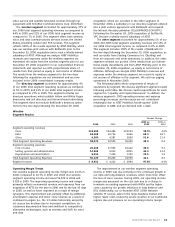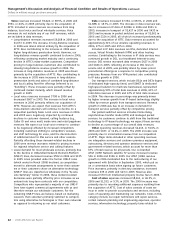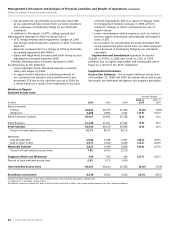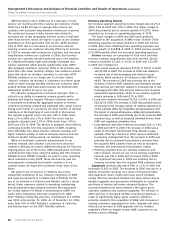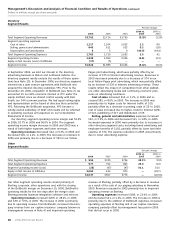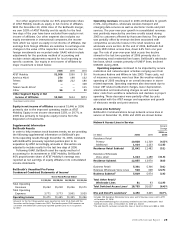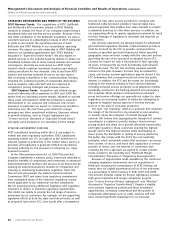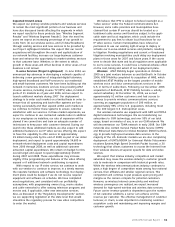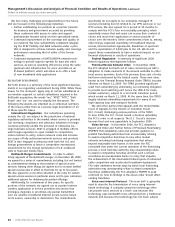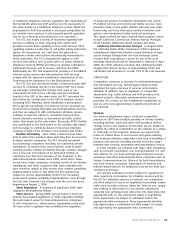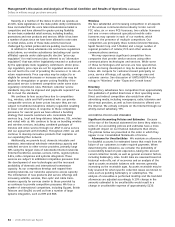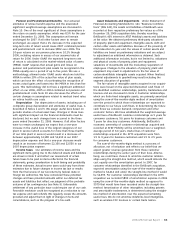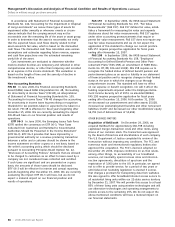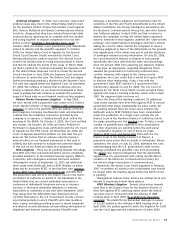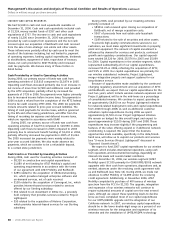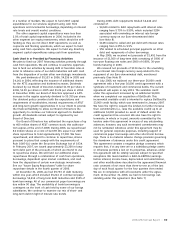AT&T Wireless 2006 Annual Report Download - page 32
Download and view the complete annual report
Please find page 32 of the 2006 AT&T Wireless annual report below. You can navigate through the pages in the report by either clicking on the pages listed below, or by using the keyword search tool below to find specific information within the annual report.
30 : :
2006 AT&T Annual Report
Management’s Discussion and Analysis of Financial Condition and Results of Operations (continued)
Dollars in millions except per share amounts
OPERATI N G ENVIRO N M E N T AND T R E N D S OF T H E BUSINESS
2007 Revenue Trends Our acquisitions of ATTC, BellSouth
and BellSouth’s 40% economic interest in AT&T Mobility
continue to change the focus of our company toward being a
broadband/data and wireless service provider. Because of the
late 2006 completion of the BellSouth acquisition, we expect
reported revenues to substantially increase in 2007 compared
to 2006 as we include the operating revenues of both
BellSouth and AT&T Mobility in our consolidated operating
revenues. We expect our sole ownership of AT&T Mobility will
enhance our bundling opportunities (see “AT&T Mobility”
discussed in “Expected Growth Areas”). We also expect to
expand services in the national business market, to utilize our
broadband network and to move toward wireless and wireline
convergence. Recently we announced our AT&T UnitySM
initiative which combines residential, business and wireless
calling and allows for free domestic calls to and from AT&T
wireline and wireless numbers. However, we also expect
that increasing competition in the communications industry,
including the continued growth of comparable alternatives,
such as wireless, cable and VoIP, and our response to
competitors’ pricing strategies will pressure revenue.
2007 Expense Trends Acquisition and related merger
costs will adversely affect expenses in 2007 and 2008. We
expect that our operating income margin, adjusted to exclude
these costs, will expand in 2008 due primarily to expected
improvement in our revenues and continued cost-control
measures. In particular, we expect to continue net workforce
reductions over the next three years related to merger
synergies and other operational initiatives. Expenses related
to growth initiatives, such as Project Lightspeed (see
“U-verse Services” discussed in “Expected Growth Areas”)
will apply some pressure to our operating income margin.
OPE RATIN G ENVI RO NME N T OVE R VIE W
AT&T subsidiaries operating within the U.S. are subject to
federal and state regulatory authorities. AT&T subsidiaries
operating outside the U.S. are subject to the jurisdiction of
national regulatory authorities in the market where service is
provided, and regulation is generally limited to operational
licensing authority for the provision of enterprise (i.e., large
business) services.
In the Telecommunications Act of 1996 (Telecom Act),
Congress established a national policy framework intended to
bring the benefits of competition and investment in advanced
telecommunications facilities and services to all Americans by
opening all telecommunications markets to competition and
reducing or eliminating burdensome regulation. Since the
Telecom Act was passed, the Federal Communications
Commission (FCC) and some state regulatory commissions
have maintained many of the extensive regulatory require-
ments applicable to our traditional wireline subsidiaries.
We are actively pursuing additional legislative and regulatory
measures to reduce or eliminate regulatory requirements
that inhibit our ability to provide the full range of services
demanded by our customers. For example, we are supporting
legislative efforts at both the state and federal levels, as well
as proposed rules at the FCC, that would offer a streamlined
process for new video service providers to compete with
traditional cable television providers. Several states have
passed legislation that enables new video entrants to acquire
a statewide franchise to offer video services. In addition, we
are supporting efforts to update regulatory treatment for retail
services. Passage of legislation is uncertain and depends on
many factors.
Our wireless operations are likewise subject to substantial
governmental regulation. Wireless communications providers
must be licensed by the FCC to provide communications
services at specified spectrum frequencies within specified
geographic areas and must comply with the rules and policies
governing the use of the spectrum as adopted by the FCC.
Licenses are issued for only a fixed period of time, typically
10 years. Consequently, we must periodically seek renewal
of those licenses. The FCC has routinely renewed wireless
licenses in the past. However, licenses may be revoked for
cause, and license renewal applications may be denied if the
FCC determines that a renewal would not serve the public
interest. In addition, the FCC and the states are increasingly
looking to the wireless industry to fund various initiatives,
including universal service programs, local telephone number
portability, services for the hearing-impaired and emergency
911 networks. While wireless communications providers’
prices and service offerings are generally not subject to state
regulation, an increasing number of states are attempting to
regulate or legislate various aspects of wireless services,
such as in the area of consumer protection.
The term “net neutrality” refers to a principle that underlies
the design of the Internet (or any network) as non-selective,
or neutral, about the transport of content through the
network. We believe that segregating the transport of content
according to a customer’s priority (using a tiered services
pricing model) will allow us to provide advanced functionality
and higher quality to those customers desiring the highest
speeds and/or the highest volumes while maintaining, at
lower prices, the bandwidth or quality of service desired by
the public. We comply with the FCC’s four net neutrality
principles, which essentially ensure that end-users can access
their content of choice, and reach their application or service
provider of choice over the Internet. In connection with
receiving the FCC’s approval, we agreed to certain commit-
ments related to net neutrality (see “BellSouth Merger
Commitments” discussion in “Regulatory Developments”).
Because of opportunities made available by the continued
changing regulatory environment and our acquisition of
BellSouth, including the consolidation of AT&T Mobility, we
expect that our capital expenditures will be in the mid-teens
as a percentage of total revenues in both 2007 and 2008.
This amount includes capital for Project Lightspeed, wireless
high-speed networks and merger-integration projects
(see “U-verse Services (Project Lightspeed)” and “Wireless”
discussed in “Expected Growth Areas”). Despite a slightly
more positive regulatory outlook and these broadband
opportunities, increasing competition and the growth of
comparable alternatives such as cable, wireless and VoIP
have created significant challenges for our business.



